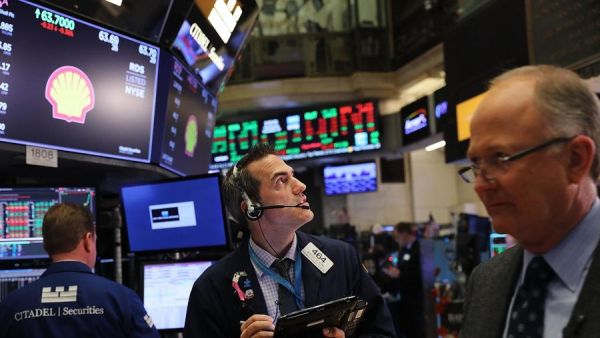Here are the top five things you need to know in global markets today Tuesday, February 6:
1. US futures swing violently to recover from historic plunge
U.S. stock index futures pared significant losses ahead of Tuesday's opening bell, but Dow Jones futures still pointed to a negative open as a historic sell-off continued to weigh on sentiment worldwide.
During Monday's late hours, Dow Jones futures were down by as much as 850 points at one point, while S&P 500 futures were lower by around 100 points. But futures made a sharp u-turn in Europe, erasing most of their declines in an extremely volatile overnight trading session. By around 3:45AM ET, Dow futures reversed losses to rise some 100 points, with the Nasdaq and S&P 500 futures also recovering somewhat.
Will the US Dollar Recover in 2018?
The roller-coaster ride continued, with Dow futures last down around 100 points, or 0.4%, while S&P 500 and Nasdaq futures pointed to modest gains at the open, with both up around 0.2%.
U.S. stocks plunged on Monday, with both the Dow and S&P 500 indices slumping more than 4%, as the Dow notched its biggest intraday decline in history with a nearly 1,600-point drop and Wall Street erased its gains for the year.
While there was no particular piece of news that pushed major U.S. indexes deep into the red on Monday, the recent moves in the bond market have added volatility and concern to the market.
Rising bond yields can crimp demand for assets perceived as riskier, such as stocks, particularly when those yields are higher than those of equities.
2. Stock market plunge spreads to Asian, European markets
Stock markets across Asia and Europe nosedived after the steepest fall on Wall Street in six years shattered years of calm.
Asian equities were covered in a sea of red, with Japan's Nikkei tumbling 4.7%, or 1,071 points, its largest such decline since the U.K.’s vote to leave the European Union in June 2016. Benchmarks in China, Hong Kong and Taiwan all suffered declines of 3%-to-5%.
Asian Markets Fall as Dow Jones Suffers Worst Day in Six Years
Meanwhile, in Europe, the continent's bourses suffered a sharp selloff at the open, with most indices down about 3%, as weakness seen in markets overseas weighed on sentiment. Autos, banks and insurance stocks were the most impacted by the sell-off, down by about 2%.
3. Global demand for gold shrinks
Overall global demand for gold jewelry weighed in at 2,135.5 tonnes (up from 2,053.6 tonnes in 2016), helped along by improved offtake in India (up 12 per cent to 562.7 tonnes) and China (at 646.9 tonnes and a gain of 3 per cent), based on estimates by the World Gold Council (WGC).
Gold Jewelry Demand in UAE Falls to 20-Year Low: Report
But overall demand for gold took a bit of a dent in 2017 across the Middle East according to WGC, with gold jewelry demand in the UAE falling for the fourth consecutive year in 2017, to a 20-year low. Saudi Arabia remained the biggest market for gold jewelry in the Middle East region, accounting for 45.7 tonnes (down from 49.4 tonnes). Among Middle Eastern markets, only Iran came out with a strong demand, up 12 percent to 45.4 tonnes.
4. Bitcoin continues to suffer, breaking below $6,000
Bitcoin prices were on the backfoot yet again, briefly breaking below the $6,000-level, as a selloff sparked by fears over tighter regulation of cryptocurrencies deepened.
Bitcoin was last down around 16% at $6,535 on the Bitfinex exchange, after falling as low as $5,947 earlier, the weakest level since mid-November. With that decline, Bitcoin has now lost roughly 60% for the year so far.
Ethereum, the world’s second largest cryptocurrency by market cap, was down 20% at $636.80.
Meanwhile, Ripple's XRP token was trading at $0.63001, also down around 20% for the day.
Bitcoin Trades Below $10,000 in Worst Decline Since 2015
Bitcoin and rival cryptocurrencies have been hit by a range of factors, including fears over tighter regulation and ongoing concerns over digital currency tether and its ability to collapse the bitcoin market.
Cryptocurrency regulation looked likely to remain in focus on Tuesday as lawmakers in the U.S. Senate prepared to question the heads of the Commodity Futures Trading Commission and the Securities and Exchange Commission over how to better regulate the virtual currency market.
5. Dollar, bond yields snap back as investors buy more
The U.S. dollar slipped along with government bond yields, after earlier gaining when investors had dumped riskier assets for the relative safety of the greenback and bonds, but currency and debt markets were generally calm compared with the rout in equity markets.
The dollar index, which gauges the U.S. currency against a basket of six major rivals, was a shade lower at 89.40. The sell-off across world stock markets sent investors rushing into the dollar on Monday, helping the U.S. currency perform well against the euro, British pound and commodity-linked currencies.
Meanwhile, the U.S. 10-year Treasury yield slid about eight basis points to 2.719%, down from a four-year high of 2.885% set on Monday, as investor risk aversion triggered a drop in yields.
Editor's note: The article has been adapted from its original source.








